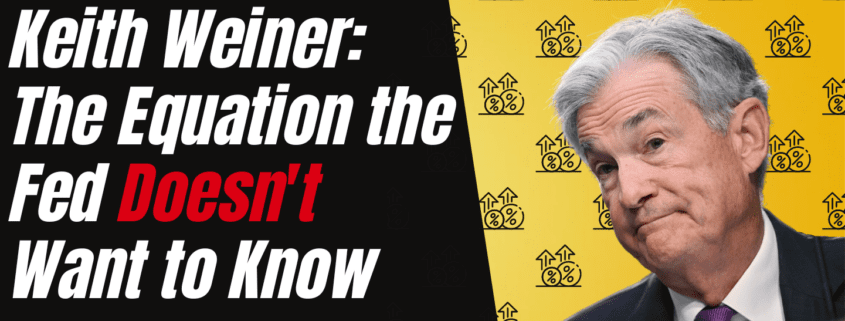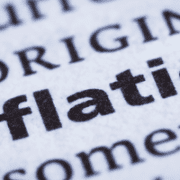The Equation the Fed Doesn’t Want to Know
“The return on capital must be greater than the interest rate.” Watch CEO Keith Weiner debunk the quantity theory of money and greedflation, and explain why his equation proves that the Fed is fighting against the laws of economics.
Connect with Keith Weiner and Monetary Metals on Twitter: @RealKeithWeiner @Monetary_Metals
Additional Resources
Why Today is NOT like the 1970’s
The Case for Gold Yield in Investment Portfolios
Podcast Chapters
01:13 Physics Envy
04:05 MV=PQ…..
07:15 QTM…
09:57 Greedflation…
11:19 Useless Ingredients
13:51 R Greater Than I
17:36 The Fed Raising Prices
21:21 Lags in the Theory
24:33 Variable vs Fixed Rates
29:19 Simon-Ehrlich Wager was WRONG
31:35 Gold vs Dollar Interest Rates
34:47 Axiomatic or Empirical
37:53 Monetary Science
38:59 Monetary Metals
Transcript:
Benjamin Nadelstein:
Welcome back to the Gold Exchange podcast. My name is Benjamin Vern Nadelstein. I’m joined today by the founder and CEO of Monetary Metals, Keith Wiener. Keith, how are you doing today?
Keith Weiner:
Doing good. Doing good.
Benjamin Nadelstein:
Keith, you wrote a really interesting article recently that makes a lot of provocative claims called Keith Wiener’s Macro Economic Equation. You decided to dip your hat into the macro equation world. Why don’t you tell us, first of all, why you did this, why macro economics and equations usually don’t go together, and some of the failed attempts along the way, before we get to hear your equation?
Keith Weiner:
There’s a saying that I’ve never contributed to spreading this rumor, by the way. I just want to make that clear. But there’s a rumor going around that macroeconomists have physics NB. And so, of course, in physics, PV equals nRT pressure times volume equals number of, I think, number of molecules times the constant times temperature. And no matter what you do, you can lower the temperature, you can increase the volume. That relationship always holds true. And the world of economics is frustrated that in a lot of ways, microeconomics is pretty well understood. If I have a choice between two gas stations right next to each other at the same exit on the highway and one is saying $5.89 and one is saying $5.99, I’m going to choose the $5.89. And so will most other people. And it’s pretty easy to go observe that. There’s a line at the 589 one and the $5. 99 one is empty. There’s some pretty well developed microeconomics. The problem is how do you translate it to macro? And I think that the macro guys genuinely are engaging in numerology. The equation that I pick on in particular is MV equals PQ.
And so that M is the quantity of money or the amount of money. V is so called velocity, P is the price level, and Q is quantity of goods. And they treat this like this is P V equals NRT. I mean, there it is F equals MA, but it’s not. It doesn’t necessarily hold. So they do these so called empirical observations which commit what I call the greatest economic fallacy everywhere, ever committed, which is you look at the economy now and then you change one variable and you look at the economy whatever year later, and you assume away the 300 trillion, trillion, trillion changes that have occurred in the economy in the last year. And it’s really easy and therefore tempting and convenient to assume that the only change that matters is the one that you change. So you increase quantity of money by whatever, and then you measure it and say, okay, this equation appears to hold true. And so what you’re doing is at best a post hoc assumption that correlation equals causality, ultimately. I mean, if there’s an equation, then it’s something that’s causing something. And when you look at MV equals PQ, if you’re a student of real science, right?
So I didn’t graduate. I was going to say I had a science degree. I dropped out. But I was in a real science major and had real physics labs and things like that. Mv equals PQ, velocity is what any student who’s been in a real science lab, in a chemistry lab adding things that you know because you measured out how much of this acetic acid you’ve added and how much silica acid you’ve added, how much acetyl salicylic acid, which is aspirin, you’re supposed to get on the filter paper when it all dries out. And when it doesn’t add up to that amount, every science student would be familiar with the term fudge factor. It’s something that you plug in to make it work, which is obviously frowned upon. There’s an ethical problem with that. And so that’s what V is in this. And so I posted a series of graphs on Twitter in the last few days looking at for the last 11 and a half years, that time frame was chosen for one odd reason, which is I went to Google and I just said price of copper, and it puts up a chart and I clicked max, zoom out and show me the longest time possible.
Just being lazy. I mean, there’s other charts of copper that go back a lot longer and it happens to go back to January of 2012. So 11 and a half years ago. Price of copper is down, price of crude oil is down, price of wheat is down. So you have arguably the most important industrial metal, the most important energy and the most important food. All three of them are down, despite all the so called money printing. And getting back to MV equals PQ, supposedly, allegedly equal to, it’s amazing at how many responses I get where it’s like, well, demand for money went up and well, supply of copper went up. And it’s like, I don’t see anything in this equation that says anything about demand for money. And of course, the very same people that at the time, in real time during each of the QE episodes was predicting hyperinflation and imminent inflation, commodity super cycle, on and on and on. The very same people are now saying, Well, in retrospect, this explains it. I’m like, Your equation doesn’t explain it. You didn’t predict it. You predicted the exact opposite, and here we are. And it seems like people would be willing to accept almost anything other than that their cherished sacred cow trope, MV equals PQ, it’s false.
Benjamin Nadelstein:
I tend to see this a lot when it comes to specifically these macro equations as we’re calling them, that if these are true, if these really do hold constant, it should be very obvious without even looking axiomatically that the price of copper went up. Do you think that the supply of money or the velocity, shouldn’t those things have all of those different equations factored into them? Otherwise, your equation is missing a variable. And so if they said, oh, well, the demand for money went up, you note, well, why isn’t that in the actual equation itself? Why is it that there’s this miss between the real world situations where people’s demand for money apparently is a variable that they missed, and then the actual equation themselves? How do they miss that every time?
Keith Weiner:
Well, I think there’s a reason why people want to believe that in the quantum theory of money. And so when the monetized equation is obviously… When there’s a counter factual to it, rather than questioning the monetized equation, I’d rather question you. People attacked my appearance, my last name, my nose, my lifestyle, you name it, came out on these threads. One person said, Troll, muted or blocked or something like, Troll? Really? I posted a price graph. I said, Why do you think this is so? That’s a troll? And he came to my thread to do that. It’s a cherished notion. And I think that there’s a very convenient… I’m not necessarily saying this is the motive of most of the people on Twitter, but at a higher level, if you were an ideological leader, a thought leader in this whole thing, there’s a real reason why you want everybody blaming the Fed for rising prices. And that is it gives you a complete blank check for all of the regulations, all the green energy restrictions, all the terrorists and the trade wars and lockdown and whiplash and all the rest of the non monetary things that governments do and redirects with a slight of hand, everybody, look over here.
What the Fed did. And then the Fed turns into a whole different schools of thought competing. And he said, she said, and this equation predicts this and this equation predicts that. And you see, we have to manage the money supply to manage the GDP and the unemployment. It becomes very complicated. It turns into statistics and equations and everybody is defeated and they’re like, I just know it. Prices went up. The Fed is doing this to me. But when you get into the Fed argument, you really get nowhere and you just run around in circles. And I think that’s a very convenient state of affairs for the regulators and the taxinators. They’re free to add useless ingredients left and right and escape the blame of it. And so for whatever reason, this is one of those sacred cows that I guess I’ve always been that perverse kid, that kid who stood up and said, The Emperor has no clothes. There’s just something inside of me that isn’t necessarily contrarian, but when the crowd is wrong, I’m just itching to just jump up and say something. And so that’s what I did.
Benjamin Nadelstein:
So, Keith, I like following this economist on Twitter. His name is Brian Albrecht, and I’ve seen a bunch out there destroying this narrative that the reason that there’s all this price inflation, the prices are rising is because of greedy corporations. And he says, The thing about this that doesn’t really make any sense is why would prices ever go down? I mean, why would the corporations get less greedy? It doesn’t really explain these obvious counter factuals. What he says instead is, look, you can look at factors like supply and demand, one of them being we have an egg prices, the price of eggs has shot the moon, and then of course, it’s fallen back down. And so he’s saying, what, the egg companies got less greedy? Of course, that can’t be the case.
Keith Weiner:
I mean, greed is a constant. I mean, in a certain level, and I realize greed is a very loaded word that can mean a lot of different things to a lot of people. But whatever it might mean, everybody has the same greed yesterday as they have today as they have tomorrow. And so you can’t use a constant to explain change at the margin. There has to be a change of some variable at the margin to explain a change of some other variable at the margin. So the socialists love to blame the greed of the capitalists for every real or imagined wrong insult, offense, outcome that doesn’t match their demands. It’s always greed, greed, greed, greed, greed, greed.
Benjamin Nadelstein:
So can you maybe quickly distinguish between things that make prices rise that are actually having to do with something like the Fed, if you think that is the case at all, or something that is completely nonmonetary, something like you call a useless ingredient?
Keith Weiner:
The thing that made me think of useless ingredients, the idea that there’s something added to something, an ingredient that’s useless is… I don’t know if this is true. I’ve seen it is all over the country. But here in the hot desert Southwest, there’s a different formulation of gasoline for the summer months. And for a while, they had to put ethinol in. But I think there’s issues with ethinol and modern fuel injector systems. So then they changed it to some chemical called MBTE, probably Methel Buda, Tetra, I don’t know, something like that. And what that does is every summer when the law mandates the cut off, the cut off, price of gas jumps 30 cents or something. It’s pretty noticeable. And the thing is, MBTE does not do anything for the consumer. If you put it in your car, it doesn’t improve your engine’s reliability, it does not improve horsepower, it does not improve fuel economy. In fact, it makes fuel economy slightly worse. Imagine that putting something into your gas engine that isn’t really a fuel for environmental reasons, makes your fuel economy go down. You have to buy more gallons of it, and the price of the gallon is up.
I thought, Well, this is a completely useless ingredient. And then I was like, AHA, ding, useless ingredients. And the economy, every productive enterprise is just full of these things. If you’re manufacturing bread, even if you’re just baking it for sale, I think if you sell it fresh, like in a restaurant, you don’t have to put preservatives in it. But if you put it in a bag and put a little twist tie on it and say this is now for sale in a store, you have to put preservatives in it. Everything you look at, cars have 17 airbags nowadays or whatever. Everything that’s out there has all kinds of compliance, mandated costs added to it. The key is that it doesn’t do anything for the consumer. The consumer doesn’t value it and usually in most cases doesn’t even know about it. Now, as to monetary forces driving prices up, I think that’s what we’re going to get into in the meat of the discussion. I know this macro equation that I put out.
Benjamin Nadelstein:
So, Keith, let’s not have the audience wait any longer. We want to hear what is Keith Wiener’s macroeconomic equation? What is it explain it to us and explain what it actually can predict and discuss the actual implications for the real world.
Keith Weiner:
So I wrote it as R is greater than I. And so I guess technically the scientists and mathematicians among us are going to say, It’s not an equation, it’s an inequality. But you have terms on both sides that units have to match. That’s another problem with the monetists. They try to compare money supply, which is a stock’s picture, total tons of gold, outstanding, and good supply, and they’re trying to compare the two, good supply is a tons per year and money supply is a tons. You have to compare things that have the same units as any… I was going to say first year university student in science, I was going to say any serious student of science at the high school level would get a brief crash course in analyzing the dimensions of those dimensional analysis. R is greater than I. So what does that mean? R is the return on capital and I is the interest rate. What I’m saying is that no matter what happens to the interest rate, the return on capital, eventually now there can be lags, I’ll get into that. But return on capital has to be greater than the interest rate because the interest rate is the cost of capital.
Here’s the axiom of this. If let’s say I run a restaurant and I’m looking at opening up another store. Professionals who do this, especially in something as well understood as restaurants, they get the demographics data for their little geo. They know that for McDonald’s, it’s a four and a half mile radius and not a 5 mile radius, whatever it is. And they figure out incomes and everything else. They say, Okay, we’re going to get this much business, which means this much profit margin, and so on. And they can figure out the return on capital with reasonable accuracy. The more novel what you’re doing, the harder it is to calculate, and therefore, the higher the margin of safety has to be. But for something like a fast food place, this is pretty well understood by the big franchiso rs. So you’re looking at putting up this McDonald’s and you calculate that it’s going to get a return on capital of 5 % plus or minus, I don’t know, 0.1 %. 4.9 % to 5.1 % is what your return on capital is going to be. If the interest rate is 8 %, you can’t do it.
Now, this isn’t me going out into the economy and making a bunch of empirical measurements and then saying, Well, this has to hold true. Why does it have to hold true? Well, because, as I said, this is just basic. If you borrow at a higher cost of capital than you generate, you’re going bankrupt. It’s that simple. It reduces to this axiom and you can’t reduce it any further because that’s it. That’s what it is. Your return on capital is less, your cost of capital is more, you’re done. Now, if you have a couple of million dollars in the bank, it could take years for you to slowly go bankrupt. One of the Ernest Hemingway novels, there’s a famous line, the people in the gold and alternative investing spaces sometimes quote, How did you go bankrupt? And the character says, At first slowly, and then all at once, to the picture of the process of going bankrupt. So return on capital must be greater than cost of capital or else. And then the question is, Or else what? People think, Okay, well, that would mean that if cost of capital goes up, then you just raise your prices.
Well, that gets back to greed earlier. You have to assume that every company has already set their prices at the maximum gross margin level. In other words, if you raise prices more, volume goes down. This is called price elasticity, pretty well understood. Every business has to understand its elasticity. Some businesses are greater in elasticity, that is relatively small increases in price would result in a big drop in sales volume. Other businesses would be relatively inelastic and you could raise the price and not get that much drop in sales. But every business has already optimized that. If you try to raise prices, you’re shrinking your business, you’re making it even worse. Now, the way that this has to work is… And the same thing, by the way, with minimum wage. You can argue with people with minimum wage, oh, businesses will pass this on to the customer. I’m like, au contraire, it doesn’t work that way. What you have to do is ruin some of the businesses. You have to take them out back and shoot them by pushing their cost above their revenues. Then they die and now supply is reduced. With supply being reduced, now supply and demand says the price is going to go up.
Price doesn’t go up because they want it to go up. Price goes up because the survivors can raise their prices because there are some of it didn’t survive. So if you push up the interest rate, which is the cost of capital, then you take certain businesses out back and you destroy them. And so there’s an irony that the Fed is doing this on purpose with almost everybody cheering. Another irony is that the Fed’s paid economists, so the Fed gives a lot of grant money. Those people are on board with this. The employees of the Fed are on board with this. The think tanks that try to be neutral are on board with this. And even the Fed’s most angry, striding critics are on board with this. You have to raise interest rates to get ahead of inflation. This is mainstream. This is everywhere. But what you’re listening to right now is one of the only guys in the world who doesn’t think this is true and will actually articulate why it isn’t true. Ironically, they’re increasing the cost of capital to try to reduce demand, and what they’re going to end up doing is they have to reduce supply greater than that, more than they reduce demand.
Necessarily so. And they’ll keep destroying, keep ruining businesses, keep reducing supply until that’s true. And yes, that was also reducing demand. Every laid off worker reduces his demand a little bit. Although we live in a welfare state, demand doesn’t reduce as much as one might think when somebody is unemployed. But whatever the reduction in demand is, the reduction in supply has to be greater. So that at the end of the process, which could take years, and I suspect the Fed is going to cry uncle before this plays out all the way. But at the end of the day, you’d have to destroy enough supply that return on capital is finally above the interest rate. And boy, that would be a lot of destruction of capital. That would be a vastly higher priced world with much greater scarcity, a world that most people today either weren’t alive during or don’t remember it very well. So people of my age just remember the late 1970s. I was 12 years old in 1979. I just remember what that was like. The last time we had a rising interest rates, a durable rising interest rate cycle from 1947 to 1981.
Benjamin Nadelstein:
So, Keith, can you touch on that time span for a little bit? So when I hear your equation, I think, okay, the return on capital has to be higher than the interest rate. So when Paul Voker raised the interest rates to double digits, were there businesses that were making a higher return than that, or are you going to now discuss the leads and the lags on that actual equation playing out?
Keith Weiner:
Yeah. Well, I’m not sure about leads, but lags are pretty simple when you look at every business in a different situation. So there are businesses that… Let me take a step back. Every business that is capital intensive has to come to market at some point, even if it’s only going to the owner’s pocket, the owner is acting as the lending market to refresh its capital. Your storefront, your restaurant, your storefront gets tired, not only dated, but everything’s a little worn, a little frayed. The booths are all torn up and the wood molding has been wet vacuumed so many times that wood is just beat. You’re manufacturing something, your production tools start to become less and less reliable. I talked about watching the show Gold Rush. You’ve seen on Gold Rush, I assume most people at least seen one or two episodes. Most of these miners are trying to make do with bulldozers and whatnot that are 40 years old or something, and they’re constantly breaking down. So there’s a point at which you say, you know what, this old junk isn’t worth trying to do one more round of duct tape and bailing wire, put away MacGyver and call up the Caterpiller dealer and get a new one.
So you’re coming to the capital market, that’s the time when you suddenly realize, oh, shit, I don’t have a business case for this anymore. This doesn’t make any sense. In the meantime, you can keep operating for a while. And so businesses that have a greater amount of capital may look around at their competitors and say, I can outlast them. And or in a capital intensive business, let’s say take mining, you just spent a billion dollars over the last five years building and opening a mine. Now that that’s sunk, what are you going to do? You either write off a billion dollars investment or you may be operating the mine. Let’s say some of your loans are at a variable rate. I’ll get back to that one in a moment, variable versus fixed rates and what businesses tend to do. Some of you said a variable rate, rate goes up. It may be better to operate that thing in a $10 million annual loss than to write off a billion dollars and hope for better days. If you look around at the copper mining industry, you might find a dozen mines that are more likely to go out of business sooner.
Keith Weiner:
And so you say, Okay, well, we’re going to make a $10 million loss for three years. We’ll lose 30 million, then we’ll be able to raise prices. So there’s this big lag from when the rate has changed until when that’s fully priced in to the market?
Benjamin Nadelstein:
All businesses have to face this equation at some point. The question is, at what point? At what point do they have to come back to the capital market and face this equation? And then we mentioned that some businesses with more capital might be willing in a survival strategy to take these losses, hoping that their competitors have to drop out and that when their competitors are gone, the supply is lowered, they can maybe still survive and raise prices to try to try to catch back up. Then the question is about variable rates and fixed rates. So what do most businesses tend to choose and why?
Keith Weiner:
So in a rising rates environment, which was post World War II through 1981, everyone knew the rates were rising. That was just like everybody in our era knows that real estate prices go up and stock prices go up. Well, at that time, everyone knew the rates went up. I remember the expression from that time was bonds were called certificates of confiscation because of the capital losses. You’d buy a 10 year government bond and sure, you’re getting this coupon and maybe that coupon was attractive, but you’d immediately be suffering capital losses. And so in that environment, if you know that rates are going to be going up and you’re planning for that, you want to borrow with as long a fixed rate term as you possibly can because, okay, I borrow now, I lock it in and that’s it. In a falling rates environment, you want a short term as possible with one cautionary factor that makes you not want to just have something that’s daily variable. And that is that there can be little spikes and the market can seize up. But if you’re using three-month commercial paper and then the market has a little hiccup, you can’t roll your liabilities at the critical moment.
So I imagine most corporations in this late stage, I mean, the socialists call it late stage capitalism. It’s more like late stage central bankism. Most corporations are probably in the two year maturity range, which is short enough it’s not really that sensitive to interest rates. If interest rates go down, you can refinance soon enough. If interest rates go up, then you’re also refinancing soon enough and that’s the problem. Companies use a strategy fitting to their environment. And of course, they’re not macroeconomic geniuses. They’re just looking at the big trend. I wanted to touch on because you’re asking about Volcker and what he did in 1981. The trend from 1947 to 1981 had all sorts of drivers outside the scope of this podcast, which don’t exist today. The rising interest rate was a ratchet effect. It would only go up. Yes, there were corrections, I get that, but there was a ratchet driving it up. The way today there’s a ratchet driving it down, and the Fed today is fighting that ratchet, and we’ll see how much longer they can hold the line against that. What Volker did mostly was be in the right place at the right time, like Harry Potter.
Is he really that heroic or is he just the guy who just happens to be holding the wand when it doesn’t really work right, screaming when XYZ happens with Voldimort. Volker happened to be there. Everybody credits him. But the rising trend had depleted by that point its drivers. He may have accelerated or exacerbated the last year or so of it by spiking rates. Rates finally got so high that they got above marginal return on capital, coming back to this idea and reversed it the other way. And then liquidation of inventories began at that time. Today, you can’t just dictate… The Fed is not bigger than the market. You can’t just dictate, I want rates to go up. There’s a dynamic that drives this, which is, again, outside the scope of this podcast, I put out a theory of interest and prices. I think we have an episode that discusses it. I know I presented a quick 15 or 20 minute talk at the Mises Institute on my theory of interest and prices, from which R is Greater Than I comes out as a derivative. We derives from that ultimately. But just accepting for a moment that there are drivers of all this, you can’t just raise I without these huge implications that I don’t think…
First of all, anybody appreciates today, and I don’t think the Fed is going to tolerate us one by one. They’re just ruining all the producers, and the bankruptcies will kill the banking system anyway, long before some of these other things happened.
Benjamin Nadelstein:
Maybe I can ask you to explain the equation using either gold as the monetary system instead of dollar system, and then monetary metals, maybe using our business model as an example for the R has to be greater than I.
Keith Weiner:
It almost doesn’t matter what you use. There are key differences between the dollar and gold, and in many contexts, that key difference is all the difference in the world. In this particular case, it doesn’t really matter. People, in fact, on my Twitter threads, it’s that nominal or real inflation-adjusted metal prices. By the way, I wrote an article talking about the Julian Simon, Paul Ehrlich bet about commodity prices and said it didn’t really prove what you think it proved because the bet was for inflation-adjusted metals prices. And since most things in the consumer price index are heavily dependent because they’re made from commodities, including metals. The consumer price index is going up in part because the price of the commodities is going up. And then you’re adjusting the commodities based on how much consumer prices went up to get to a so called real price of the commodity. What you’ve really measured is the spread between commodities and consumer prices. They thought that they proved that metals were becoming cheaper. What they proved is that there were more useless ingredients added to finished goods than there were commodities and the spread was widening. In other words, if you bought a product at the beginning of the bet, a greater percentage of its value was determined by the raw commodity price.
And at the end of the bet period, the less of the value was from the raw commodity price, more was either other value added steps and or useless ingredients. So they didn’t prove what they thought they proved. The winner of the bet didn’t prove what he thought he proved. Everybody who cites that endlessly, it didn’t prove that. But getting back to our graders and I, if a business has revenues in a currency, it has interest payments in a currency, it has debt in a currency, so there’s return on capital, there’s gross profits before… Or I guess there’s EBITDA, if you want to call it that, earnings before interest anyways, living inside taxes, depreciation, amortization. Earning before taxes, if all of that’s in the same currency, so your revenues are gold, your interest payments are gold, your debt is denominated in gold, or if those are dollars, the same thing is true. Now, what’s different is that the interest rate in gold is stable. It’s not subject to nudges by the central bank. You can’t have a monetary policy where they say, Well, we want to do this. It doesn’t really work. And so the moment they created the Fed, the gold standard was doomed.
And by 1933, the headsman chopped off its head, really, and then kicked around for a few more decades before finally being buried or whatever you want to call it. But gold doesn’t allow that nudging. And that’s one of the things I say about Monetary Metals, we’re the first time that an interest rate has been set in a free market since 1913. There’s no nudging. You can’t. If people don’t like the terms or the risk or the interest rate, they just pull their gold coin back. Whereas in the dollar system, you’re disenfranchised. You can withdraw. People think of a piece of paper with green ink on it as physical money, but it’s just a note. It has no meaning and no value other than that the Fed says will make good on this. It’s legal tender. And if something should happen to one of the assumptions behind that, the paper isn’t the thing. It’s the credit relationship of the Fed is the thing. And so why withdraw the paper from the bank? You’re still a creditor to the same system. If you make a withdrawal from the bank, then you’re giving credit to the Fed and the Fed is going to use that to extend credit to the bank.
And so you’re jumping out of the frying pan and into the frying pan. You haven’t actually moved your position anywhere. So that’s the main difference between the team. If you look at the gold standard years before 1913, and then look at the interest rate in particular, and then you look at the interest rate. So the Fed was created, nothing to do with unemployment and consumer prices. Those are contemporaneous or contemporary concerns that were anachronistic to try to retroactively apply to 1913. 1913, they said, smooth the business cycle. And interest rate would be a great measure of the business cycle. Pre smoothing, the interest rate was actually pretty smooth. You had existential threats like the War of 1812 and the Civil War. You had some other really gross things like the Crime of ’73 and a few other things that occurred along the way. But it’s almost table flat compared to once we created the Fed to smooth it out, boy, did it become unstable after that. And that’s why the hate gold, one of the reasons why the hate gold.
Benjamin Nadelstein:
So, Keith, I have a final question here for you. Is your equation something that is true without having to do an empirical study? So I wouldn’t go to a bunch of businesses and say, hey, is your return on capital greater than the interest rate? Is this something that’s axiomatically true in a more Austrian sense, or is this something that could be falsified itself?
Keith Weiner:
Well, obviously, if you can go out and find businesses that are borrowing, that’s easy to do. If you find businesses that are borrowing at a greater cost than their cost of capital, and you carefully assess, are there hidden subsidies that are effectively lowering the cost of capital or effectively boosting revenues or bottom line or some other thing? I don’t know if you’re running an electric car company and all of the gasoline car companies that your competitors are forced to pay you, buy from you carbon credits, for example, then your loss making car manufacturing operation could be buoyed up by essentially a rent seeking operation involving transfer payments of some sort. But if you carefully work through all of that, you’re going to find that, yes. And then you may find temporary situations where the cost of capital jumps and the business doesn’t go out of business immediately. But when you f you follow them long enough, yeah, you’re going to find there’s no such thing as a business which has a cost of capital greater than its return on capital. So it’s derived from ultimately the laws of human action. But there’s no reason why it couldn’t be verified empirically.
But it’s not doing two things. It’s not doing the empirical economist thing, which is, let’s look at zillions and zillions of variables in the economy. Let’s canvass every bit of data that we can find and randomly put groups of variables together and see if we can find some post hoc correlation. It’s not doing that. And it’s not doing the Popperian, let’s make up any old arbitrary assertion and then see if we can falsify it. If it’s not falsifiable, we reject it. And if it is falsifiable, let’s see if we can falsify it. And then failing to falsify it, at some point, we throw our arms up and say, Well, this is probably true. It’s not doing either of those things. It’s saying this has to be true. And now, yeah, sure, anybody can go out there and look. But be careful and be disciplined. To empirically verify this, you need a disciplined methodology. And as I said, that’s going to boil down to correcting for hidden subsidies and other things like that. But if you do that, yeah, show me a business that’s borrowing at 8 % to generate 5 % and it’s sustainable. In the meantime, pardon me while I go look for a bridge in Brooklyn to buy for 100 bucks.
Benjamin Nadelstein:
Keith, I want to thank you so much. I suggest everyone go read the article. That will be in the description. We’ll put lots of your theory of interest and prices in there as well and lots of other great articles. Keith, any final words before we go on your equation?
Keith Weiner:
What I want to encourage with this is people to think about the scientific method and how the scientific method applies to economics. In my article, I talked about this is what economists think that physicists are doing. And I say, never mind, that’s not actually what physicists are doing. But the scientific method is a process of looking at reality to try to understand identity and causality of things. From that, equations come, rather than just looking at data that you don’t understand and post hoc picking things up, or goal seeking, when you already know what you want to prove before you’ve even really studied it, and now you’re just looking around for post hoc things to rationalize it. If we had more scientific method applied to economics, the world would be a better place.
Benjamin Nadelstein:
Couldn’t think of a better place than the episode. Thanks so much, Keith, and we’ll see you on the next episode of the Gold Exchange podcast. This episode was brought to you by Monetary Metals. Monetary Metals is a different gold company. Others buy and sell gold. Monetary Metals operates the gold yield marketplace, a platform of products that offer a yield on gold paid in gold to investors and institutions. Our gold financing simplified, reliable financing denominated in gold with a built in hedge for gold using and gold producing businesses. To learn more, visit www. Monetarydashmetals. Com. See you next time.
Additional Resources for Earning Interest in Gold
If you’d like to learn more about how to earn interest on gold with Monetary Metals, check out the following resources:
In this paper, we look at how conventional gold holdings stack up to Monetary Metals Investments, which offer a Yield on Gold, Paid in Gold®. We compare retail coins, vault storage, the popular ETF – GLD, and mining stocks against Monetary Metals’ True Gold Leases.
The Case for Gold Yield in Investment Portfolios
Adding gold to a diversified portfolio of assets reduces volatility and increases returns. But how much and what about the ongoing costs? What changes when gold pays a yield? This paper answers those questions using data going back to 1972.













Leave a Reply
Want to join the discussion?Feel free to contribute!